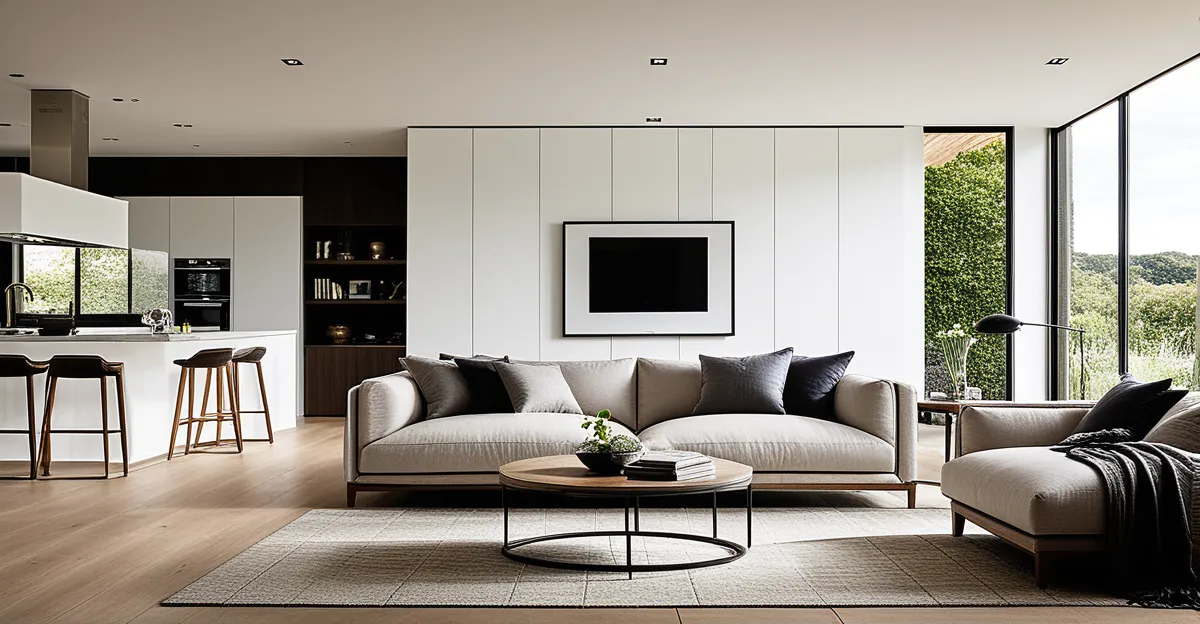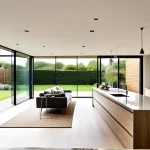The Impact of Color Schemes on Mood
Color psychology plays a pivotal role in interior design, influencing the emotions and ambiance of a space. Choosing the right color palette can significantly enhance one’s mood, promoting relaxation or creativity. Warm colors, such as reds and oranges, tend to evoke energy and excitement, making them ideal for creative environments. In contrast, cool colors like blues and greens are known for their calming effects, suitable for spaces meant for relaxation.
Incorporating new colors into a living space doesn’t have to be daunting. Simple changes, like adding colorful accessories such as cushions or artwork, can transform the feel of a room. These additions can serve as focal points, drawing attention and enhancing the overall mood. Moreover, using diverse color palettes in different rooms can reflect and support their varied functions, from restful bedrooms to invigorating home offices. By thoughtfully selecting and introducing colors, one can effectively tailor the ambiance to suit personal preferences and functional needs.
This might interest you : What are the key elements of a traditional UK home design?
Furniture Arrangement for Flow and Function
Creating an effective furniture layout is essential for optimizing both space and functionality within a room. The way furniture is arranged can significantly influence social interactions and the flow of traffic, impacting the overall usability of a space.
One key technique for space optimization involves grouping furniture to promote natural conversation zones. For instance, arranging sofas and chairs in a circular or semi-circular configuration can enhance dialogue by making it easier for individuals to maintain eye contact and engage comfortably. Additionally, ensuring clear pathways between pieces supports better room flow, allowing effortless movement and reducing clutter.
This might interest you : What Are the Key Trends in Modern UK Home Design?
For those looking to maximize existing furniture without significant overhaul, consider focusing on decluttering. Removing extraneous items not only frees up space but also highlights the primary furniture pieces, enhancing utility and room aesthetics. Utilize clever storage solutions, such as built-in shelves or multifunctional furniture, to save space and keep the area organized. By thoughtfully arranging furniture, you can balance flow and function, creating spaces that are both inviting and practical.
The Role of Lighting in Living Spaces
Lighting design holds a transformative power in any living space, impacting both mood and functionality significantly. Natural light is perhaps the most crucial element, as it positively influences well-being, reducing stress and enhancing productivity. When natural light is limited, mood lighting options like lamps or LED fixtures can create warm, inviting environments that mimic daylight.
Choosing the right lighting design involves understanding the purpose of each room. In areas where focus is required, such as a home office, brighter task lighting can prevent eye strain and boost energy levels. Conversely, softer, dimmable lighting in the bedroom promotes relaxation and sleep quality.
Simple adjustments to existing lighting can enhance a room’s ambiance without needing extensive renovations. Consider repositioning mirrors to reflect natural light deeper into a room, increasing brightness and fostering a more open feel. Table lamps and floor lamps with adjustable settings can also provide versatility in creating desired atmospheres.
Ultimately, integrating a thoughtful lighting design strategy in your living spaces not only caters to functional requirements but also subtly adjusts hues and intensities to suit various moods, adding comfort and sophistication to your home.
Incorporating Textures and Fabrics
Exploring how textures influence the sensory experience of a home can elevate comfort and ambiance. Adding layers of fabrics within a room can generate visual interest and tactile satisfaction, enriching the overall feel of a space. Integrating textural variety through means such as throw pillows, rugs, and curtains allows for simple yet impactful transformations.
Layering fabrics strategically can achieve a harmonious balance between aesthetic appeal and comfort. For instance, a mix of velvet, cotton, and linen can create a refreshing dynamic, combining warmth and softness with breathable lightness. This interplay not only heightens sensory pleasure but also enhances the room’s cozy aspect.
Affordable textural changes don’t demand large-scale renovations. Consider small but effective tweaks like introducing a chunky-knit throw over a sofa or a textured area rug beneath a coffee table to add dimension. When selecting fabrics, opt for a diverse palette of patterns and materials to sustain interest and personalize the space.
Textural variety, when thoughtfully curated, effectively invigorates the home ambiance. Such adjustments not only uplift a room’s aesthetic but also infuse comfort, making your living spaces more inviting and lively.
The Effect of Greenery on Indoor Spaces
Indoor plants can significantly enhance both the aesthetic and health aspects of one’s living environment, providing a harmonious blend of aesthetics and functionality. Introducing biophilic design elements such as plants not only enriches the decor but also purifies the air, leading to improved air quality. This natural enhancement supports overall well-being, as cleaner air reduces toxins and increases oxygen levels, benefiting those within the space.
For those with busy lifestyles, it’s comforting to know there are easy-to-maintain plants that require minimal upkeep yet offer substantial benefits. Consider species like snake plants, pothos, or peace lilies, which thrive with little care. Their robust nature makes them ideal for individuals who might not have a green thumb but still want to reap the rewards of having greenery indoors.
The strategic placement of plants is crucial to maximizing their benefits. Positioning them near windows can increase their access to natural light, enhancing their growth and impact on air quality. Hanging plants or using vertical planters can save floor space while adding layers and depth, contributing to an overall sense of calm and freshness. By thoughtfully integrating indoor plants, one can effectively bolster the beauty and health of their home environment.
Utilizing Mirrors for Space Enhancement
When it comes to creating the illusion of space within a room, mirror tricks prove invaluable. By reflecting light and images, mirrors can make spaces seem larger than they are. Positioning a large mirror opposite a window captures natural light and disperses it throughout the room, enhancing both light reflection and space perception. This technique not only brightens the area but also adds depth, giving the impression of a more expansive environment.
Innovative mirror placements can further boost these effects. For example, placing mirrors along narrow hallways or behind light sources like lamps becomes a powerful method to expand and illuminate compact areas, dramatically transforming their feel. By considering the angles and heights at which mirrors are placed, you can maximize these benefits, achieving both aesthetic appeal and spatial enhancement.
Selecting the right mirror style is essential to seamlessly blend with your interior design. Options range from minimalistic frames that blend into modern decor to ornate designs that can serve as a focal point. By choosing styles that complement the existing color schemes and textures, mirrors can effectively integrate into nearly any personal style, enhancing the overall ambiance while providing practical benefits.
Personalizing Decor with Affordable Art
Adding a personal touch to your home need not break the bank. Achieving a unique and comforting personal style through wall decor is attainable with budget-friendly art. There’s an abundance of options for crafting or sourcing artwork that enhances the aesthetic of your space while reflecting your personality.
Affordable Artwork Options
One way to incorporate art without overspending is through DIY projects. Creating your own pieces allows you to express individual tastes and experiment with colors and designs that resonate with your interior style. Alternatively, explore local markets or online platforms for prints and artworks that suit your budget. Affordable art doesn’t compromise quality; instead, it provides diverse artistic expressions accessible to everyone.
Display Strategies
When it comes to displaying art, consider the impact on room dynamics and ambiance. Art can become a focal point on feature walls or be part of a cohesive gallery wall, using different sized frames for visual intrigue. Whether opting for a single statement piece or a curated collection, arranging art effectively enhances room aesthetics and aligns with functional space use. Embrace these creative endeavors to infuse homes with personal charm and elegance.
Practical Storage Solutions for a Clutter-Free Home
Transform your living space into an organized haven with effective storage solutions. Keeping a home tidy doesn’t just enhance its aesthetic appeal but also ensures your surroundings remain functional. Let’s delve into how you can innovate your storage strategies.
Implementing Adjustable Storage Solutions
Adjustable storage solutions are versatile allies in maintaining organization. Consider modular shelving units or customizable closet systems, which can be altered as your needs evolve. These solutions allow you to optimize organization without compromising on personal style or the available space. They are particularly advantageous in homes with varying storage requirements, adapting seamlessly as your belongings and needs change over time.
Creating Hidden Storage
For smaller spaces, hidden storage can be a game-changer. Furniture with built-in compartments, like ottomans or beds with drawers, offers discreet places to tuck away items, keeping your space uncluttered. Another clever strategy is to utilize vertical spaces with overhead cabinets or elevated shelves that draw the eye upwards, offering storage without encroaching on the room’s footprint. This approach maintains a spacious ambiance while providing ample room for belongings.
Organizing Techniques for Functionality and Aesthetics
To marry organization with aesthetic pleasure, embrace multi-purpose solutions that enhance utility without sacrificing style. For instance, aesthetically pleasing storage baskets can be both decorative and functional, neatly stowing away essentials in living areas. Adopting this balanced approach allows your space to remain inviting and practical, showcasing your personal taste while maintaining order. By integrating these thoughtful storage methods, you can cultivate a functional, stylish, and clutter-free home environment.







